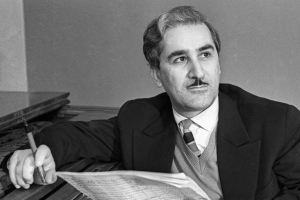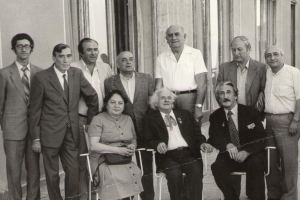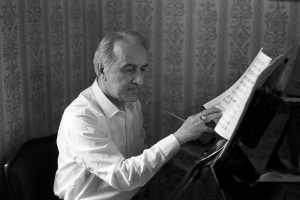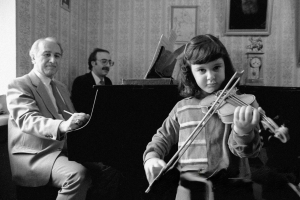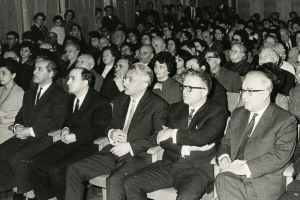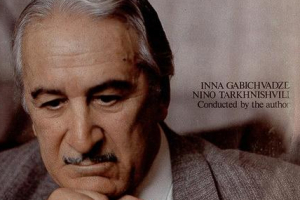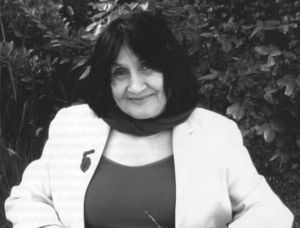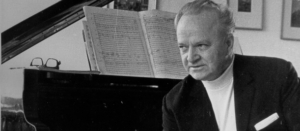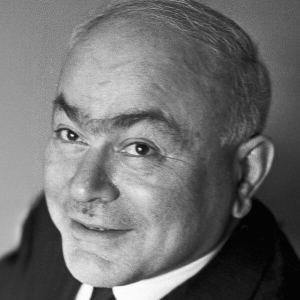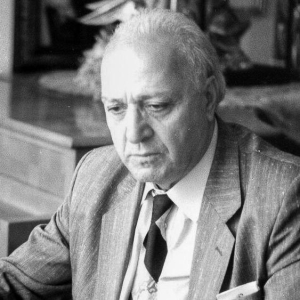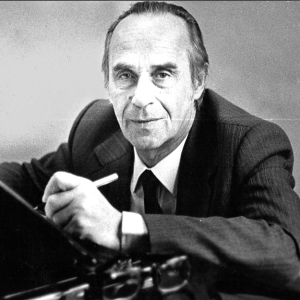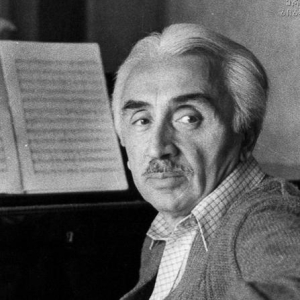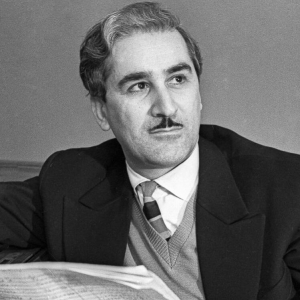Revaz
Gabichvadze
Revaz Gabichvadze
(1913 – 1999)
Revaz Gabichvadze – Georgian Composer, Teacher, Public Figure. Founder of the State Pop Orchestra of Georgia, People’s Artist of Georgia (1967). Revaz Gabichvadze is an important representative of the new Georgian professional music, who presented himself to the public as the author of large musical forms, chamber works, as well as mass and popular songs.
Date of birth – May 29 (June 11), 1913
Place of birth – Tbilisi, Georgia
Date of death – June 9, 1999
BIOGRAPHICAL DATA
1935 – Graduated from Vano Sarajishvili Tbilisi State Conservatory, majoring in composition (Iona Tuskia’s class)
1935 – 1938 – Aspirant student of Tbilisi Conservatory named after Vano Sarajishvili
1938–1980 – Teacher of Vano Sarajishvili Tbilisi Conservatory
1963 – Professor of the Department of Composition at the Tbilisi Conservatory named after Vano Sarajishvili;
In 1941, he founded the Georgian State Pop Orchestra
1941–1945 – The first head of the State Pop Orchestra of Georgia
1948 – 1952 – Responsible secretary of the board of the Union of Composers of Georgia
1982 – 1987 – Artistic director of the House of Union Composers
AWARDS AND RECOGNITION
1956 – Honored Worker of Georgian Art
1967 – People’s Artist of Georgia
1980 – Laureate of the Rostock District (Germany) Prize
Revaz Gabichvadze
(1913 – 1999)
SELECTED WORKS
MUSIC FOR THEATRE
1957 – “Nana” – Opera in 4 acts. (Libretto E. Didimamishvili)
1966 – “We – Mothers of Peace” – (“Rebellion of Niobea”) – Opera in 3 acts – (Libretto B. Starshev)
1971 – “Hamlet” – Ballet in 3 acts – (Libretto V. Chabukiani, A. Sandamirova)
1975 – “Medea” – Ballet in 2 acts – (Libretto G. Aleksidze)
1986 – “Laughing Man” – Ballet in 2 acts
1957 – “Chrichina” – Operetta in 3 acts – (Libretto M. Baratashvili, G. Stein)
ORCHESTRAL MUSIC
CHAMBER INSTRUMENTAL MUSIC
1945 – String Quartet No.1
1955 – String Quartet No.2
1963 – String Quartet No. 3
1968 – “Divertissement” – for Windwood Quartet.
1971 – 9 variations for Nonetto
1978 – Wind Quintet
1984 – “Life of Arlequin” – Symphony for Wind Quintet
1964 – Sonata No.1 – for Piano
1976 – Sonata No. 2 – For Piano and Bells
1975 – Sonatina No.1 – for Piano
1976 – Sonatina No. 2 – for Piano
1977 – Sonatina No.3 – for Piano
1978 – Sonatina No.4 – for Piano
1931 – Prelude for Piano
1958 – 6 Piano Pieces
1963 – 15 Piano Inventions
1969 – “Play of Intervals” – Suite for Piano.
1975 – 7 Micro sonatinas for Piano.
1975 – “Dawn at Ohrit Lake” – Piano Pieces for Adolescent
1976 – 3 Dances for Piano.
1976 – 3 Preludes for Piano.
1978 – “Dramatic Scenes” – from the Ballet “Hamlet” – for Two Pianos
1939 – “Aria” – for Violin and Piano.
1976 – Three Dances from the Ballet “Hamlet” – for Violin and Piano.
1978 – Duet for two Violins and Piano
1977 – Sonata for Cello and Piano
1977 – 2 Pieces for Trumpet and Piano
VOCAL INSTRUMENTAL MUSIC
1938 – “The Knight in the Panther’s Skin” – Oratorio for Tenor, Mixed Choir and Symphonic Orchestra – (text by Shota Rustaveli)
1975 – “Victory” – Song for Vocal and Piano – (text by S. Masalkov)
1976 – 2 songs – for Vocal and Piano. (text by M. Jalil)
1978 – “Truth and Love” – Vocal Cycle for Basso and Piano. (text by A. Pushkin)
1983 – Czech and Slovak Folk Songs – Children’s Songs with Piano Accompaniment – (text by S. Mikhalkov)
AUTHOR OF MANY ROMANCES INCLUDING:
“Elegy”, “Why do I love you so much”, “Worried Sea”, “Will Dry my Tears”, “The Chonguri”, “In the Mountains of Iveria”, “Georgian Nana – Lullaby”, “Rose in May”.
MUSIC FOR MOVIES AND THEATRE
AUTHOR OF MORE THAN 50 DRAMATIC PLAYS, INCLUDING:
“Samshoblo”, “Glass of water”, “Chrychichina”, “Gyorgi Saakadze”, “Khevisberi
Gocha”, “Colkheti dawn”, “Dog on the hay”, “Kutaislebi”, “Gandegili”.
“Samshoblo”, “Glass of water”, “Chrychichina”, “Gyorgi Saakadze”, “Khevisberi
Gocha”, “Colkheti dawn”, “Dog on the hay”, “Kutaislebi”, “Gandegili”.
“Samshoblo”, “Glass of water”, “Chrychichina”, “Gyorgi Saakadze”, “Khevisberi
Gocha”, “Colkheti dawn”, “Dog on the hay”, “Kutaislebi”, “Gandegili”..
“Homeland”, “Glass of Water”, “Chrichina”, “Giorgi Saakadze”, “Khevisberi Gocha”, “Kolkheti Dawn”, “Dog on the Hay”, “Kutaislebi”, “Gandegili” …
FILMOGRAPHY
1940 – “Girl from Khidobnia” – Directed by Diomide Antadze
1941 – “Treasure of Tsani Valley” – Directed by Zakaria Berishvili
1952 – “The Conquerors of Mountain Peaks” – Directed by David Rondeli
1979 – “Medea” – Film-Ballet. Directed by Giorgi Aleksidze and Elguja Zhgenti
1940 – “Jimarai Hokh” – Directed by Vladimir Valishvili
ANIMATION
1938 – “The Flea and the Ant” – Directed by Konstantine Chankvetadze
1939 – “Young Shooter” – Directed by Konstantine Chankvetadze
1947 – “Rooster” – Directed by O. Chiaureli, Vladimir Mujiri, P. Morabi.
1972 – “New Moon” – Directed by Vakhtang Bakhtadze
Revaz Gabichvadze
(1913 – 1999)
Revaz Gabichvadze’s pieces are an essential component of Georgian professional music nowadays. It is multi-genre, varied and most significantly, a reflection of Georgian professional music’s continual search and metamorphosis processes.
Revaz Gabichvadze introduced himself to the public as the author of chamber works in main musical forms, as well as mass and popular songs, from the beginning of his creative career.
The earliest significant works date from the 1930s: a Synphonieta (1935), and the Oratorio “Vepkhistkaosani” (Tigerskin) for choir, soloist, and orchestra (1937). “Poem” (1934) and “Aria” (1936) for violin. Prelude for Piano (1039). At the same time period, the composer works closely with Tbilisi’s Rustaveli Drama Theatre. A suite from “Spark” for soprano and orchestra was created according to the music written for one of the performances.
Revaz Gabichvadze composed the symphonic poem “Gamzredeli” in the early twentieth century, based on Akaki Tsereteli’s poem (1944). The instrumental concert genre was given considerable importance in Revaz Gabichvadze’s music during this time period.
His famous concertos for violin and orchestra (1947) and cello and symphonic orchestra were composed. (1951) Knowing the details and technical capabilities of the mentioned instruments gives conditions that allow the composer to reach intriguing findings. Studying the orchestra’s potential becomes such a priority for him that he founds and directs the Georgian State Pop Orchestra, which is followed by a strong appeal to the song genre and the composer’s fame in society.
The 50s of the last century distinguish prominently in Revaz Gabichvadze’s creative biography. His involvement with the musical theatre was a major event during this time period. His different experiences with dramatic theatre as well as visual art are brought together right here. There are also different vocal-symphonic or singing music genres. Meanwhile, the operetta “Chrichina” (Dragonfly), (1952), based on “Marine” by Marika Baratashvili, was produced. The Sverdlovsk Theatre effectively staged this work. This was followed by the opera “Nana” (based on A. Arbuzov’s play). Elene Didimamishvili wrote the libretto (1957). The author conducted the debut of the opera at the Tbilisi Opera Studio.
The 1950s are particularly significant due to the fact of the beginning the composer’s process of worldview growth. Gabichvadze is developing a desire for philosophical understanding, in modern world music art. Analyzing current events and putting them to creative purpose. His String Quartet No. 2 is an example of this fusion. (1955)
Talking about the composer’s own style takes us back to the 1960s, when complex harmonic language, polytextuality, and polyphonic thought were already visible… Gabichvadze’s creative tactics and skills are transforming, If previous works were founded on a singing basis, the recitative-declamatory style now takes the centre position. Instead of creating theme components, the composer opposes intonation beginnings, prefers to express himself in a thesis, moves outside of the boundaries of the tonal system, and tends towards an atonal sound.
The pieces composed in 1963 confirm the preceding: String quartet and Symphony for String Orchestra for piano and lutes. The current form is distinguished by an innovative orchestral mood. The symphony has been performed successfully in Hungary, France, Germany, Argentina, and other countries. etc… Two chamber symphonies N 1 (1963) and N2 (1968) written in the 1960s should be regarded as the peak of Revaz Gabichvadze’s artistic endeavours. Both symphonies were requested by the German city of Rostock and premiered there; Symphony No.1 was also performed in Sweden and Spain, and Symphony No.2 was performed in German cities, Sweden, and Bulgaria. Both works were written for nine instruments. In these works, Metro rhythmic beginning posture is evident. In Chamber Symphony No. 2, the author expresses his message through the Guruli folk music dialect. The Guruli tune provides him with improvisational principles as well as humorous and grotesque impulses. In general, Revaz Gabichvadze prioritises the main trend of Georgian professional music that aims at combining of national folklore elements with modern musical thinking. As a result, in the composer’s mind eternal themes are occupy a greater amount of space. Gabichvadze’s Symphony No. 2 “Vocal” – for the symphony orchestra and Mezzo-Soprano – reflects concerns of presence-absence, the world’s existence. (1971). To emphasise his point of view, the author cited the poem “Pikrni Mtkvris Piras” by the great Georgian romantic poet Nikoloz Baratashvili from the nineteenth century. Th composer Aleksandre Shaverzashvili, stated about the N2 Symphony: “The symphony is recognised as a work of art that has become a living witness to historical events on various occasions.”
It is as well motivated by identical intellectual ideas. symphonic No. 3 for symphonic orchestra, written in 1972. The work’s philosophical essence is also derived from Nikoloz Baratashvili’s poetry, as it is preceded by words from the poem “Merani.” A brilliant Georgian’s masterpiece. It was written in honour of composer Zakaria Paliashvili.
The basic idea of the Symphony is the confrontation between the ancient and new worlds, which the composer achieves by juxtaposing the sounds of an old Georgian hymn recorded on tape with the sounds of modern music. The Symphony’s idea and sound are still associated with the city of Rostock. (The piece was first performed in Rostock by the city’s Philharmonic Symphony Orchestra, conducted by G. Puls).
The ballet works “Hamlet” created in the 1970s brought Revaz Gabichvadze great success (the libretto according to Shakespeare’s tragedy was written by A. Khandamirov and V. Chabukian). (1971) and “Medea” based on Euripides’ tragedy. G. Aleksidze wrote the libretto. (1975).
The depth of dramatic expansion, complex musical texture, and colourful timbral tones distinguish these compositions. According to musicologist Mira Fichkadze, “The works attracted attention with the courageousness of the idea, the interesting access to Shakespearean characters.”
Among the composer’s latest compositions, the children’s suite “Harlequin’s Life” (for the blowing brass instruments) is noteworthy. (1984) and Double concerto for violin, cello and orchestra. (1986)
Revaz Gabichvadze’s various and extensive musical legacy deserves continuing research and study.
Musicologist
Tamar Tsulukidze
English Language Translator
Tamar Kharadze



